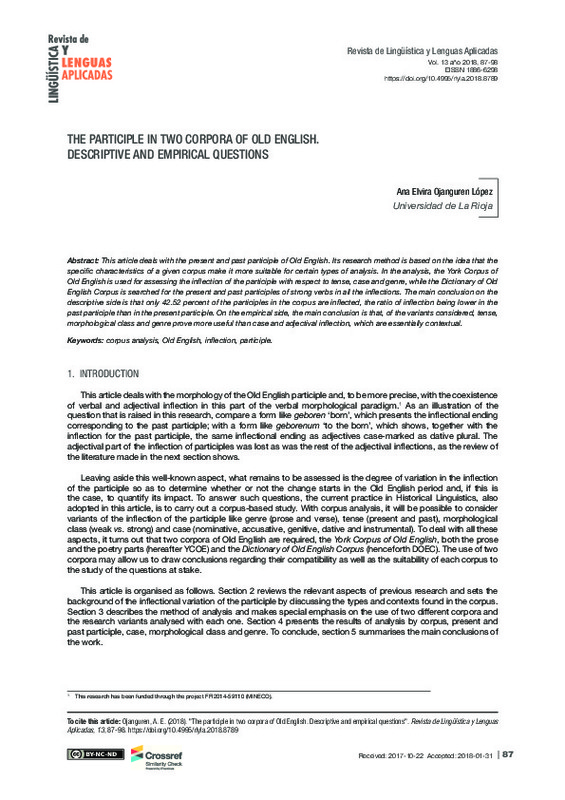Healey, A. diPaolo (ed.) with Price Wilkin, J., Xiang, X. (2004). The Dictionary of Old English Web Corpus. Toronto: Dictionary of Old English Project, Centre for Medieval Studies, University of Toronto.
Martín Arista, J. (ed.), García Fernández, L., Lacalle Palacios, M., Ojanguren López, A., Ruiz Narbona, E. (2016). NerthusV3. Online Lexical Database of Old English. Nerthus Project. Universidad de La Rioja. [http://www.nerthusproject.com]
Taylor, A., Warner, A., Pintzuk, S., Beths, F. (2003). The York-Toronto-Helsinki Parsed Corpus of Old English Prose. Department of Language and Linguistic Science, University of York [http://www.helsinki.fi/varieng/CoRD/corpora/YCOE/].
[+]
Healey, A. diPaolo (ed.) with Price Wilkin, J., Xiang, X. (2004). The Dictionary of Old English Web Corpus. Toronto: Dictionary of Old English Project, Centre for Medieval Studies, University of Toronto.
Martín Arista, J. (ed.), García Fernández, L., Lacalle Palacios, M., Ojanguren López, A., Ruiz Narbona, E. (2016). NerthusV3. Online Lexical Database of Old English. Nerthus Project. Universidad de La Rioja. [http://www.nerthusproject.com]
Taylor, A., Warner, A., Pintzuk, S., Beths, F. (2003). The York-Toronto-Helsinki Parsed Corpus of Old English Prose. Department of Language and Linguistic Science, University of York [http://www.helsinki.fi/varieng/CoRD/corpora/YCOE/].
Taylor, A., Warner, A., Pintzuk, S., Beths, F., Plug, L. (2001). The York-Helsinki Parsed Corpus of Old English Poetry. Department of Language and Linguistic Science, University of York [http://www-users.york.ac.uk/~lang18/pcorpus.html]. Callaway, M. (1901). The appositive participle in Anglo-Saxon. Baltimore: Publications of the Modern Language Association of America.
Allen, C. (2003). "Deflexion and the development of the genitive in English". English Language and Linguistics, 7/1, 1-28. https://doi.org/10.1017/S1360674303211023
Campbell, A. (1987, 1959) Old English Grammar. New York: Oxford University Press.
Clark Hall, J. R. (1996, 1896). A Concise Anglo-Saxon Dictionary. Toronto: University of Toronto Press.
Closs Traugott, E. (1992). "Syntax". The Cambridge History of the English Language. Volume I: The Beginnings to 1066. Ed. R. M. Hogg. Cambridge: Cambridge University Press. 186-201. https://doi.org/10.1017/CHOL9780521264747.005
Fischer, O. (1992). "Syntax". The Cambridge History of the English Language. Ed. N. Blake. Cambridge: Cambridge University Press. 207-408. https://doi.org/10.1017/CHOL9780521264754.005
Healey, A. diPaolo (ed.) with J. Price Wilkin, X. Xiang. (2004). The Dictionary of Old English Web Corpus. Toronto: Dictionary of Old English Project, Centre for Medieval Studies, University of Toronto.
Hogg, R. M., Fulk, R. D. (2011). A Grammar of Old English. Volume 2: Morphology. Oxford: Blackwell. https://doi.org/10.1002/9781444341355
Lass, R. (1992). "Phonology and Morphology". The Cambridge History of the English Language. Ed. N. Blake. Cambridge: Cambridge University Press. 23-155. https://doi.org/10.1017/CHOL9780521264754.003
Martín Arista, J. (2012a). "Lexical database, derivational map and 3D representation". RESLA-Revista Espa-ola de Lingüística Aplicada, (Extra 1), 119-144.
Martín Arista, J. (2012b). "The Old English Prefix Ge-: A Panchronic Reappraisal". Australian Journal of Linguistics, 32/4, 411-433. https://doi.org/10.1080/07268602.2012.744264
Martín Arista, J. (2017). "El paradigma derivativo del inglés antiguo". Onomázein, 37, 144-169. https://doi.org/10.7764/onomazein.37.05
Martín Arista, J. (2018). "The Semantic Poles of Old English. Towards the 3D Representation of Complex Polysemy". Digital Scholarship in the Humanities, 33/1, 96–111. https://doi.org/10.1093/llc/fqx004
Mitchell, B., Ball, C., Cameron, A. (1975). "Short titles of Old English texts". Anglo-Saxon England, 4, 207-221. https://doi.org/10.1017/S0263675100002799
Mitchell, B., Ball, C., Cameron, A. (1979). "Short titles of Old English texts: addenda and corrigenda". Anglo-Saxon England, 8, 331-333. https://doi.org/10.1017/S0263675100003124
Mitchell, B. (1985). Old English Syntax. Concord, the parts of speech and the sentence. Volume 1. Oxford: Oxford University Press. https://doi.org/10.1093/acprof:oso/9780198119357.001.0001
Norde, M. (2001). "Deflexion as a counterdirectional factor in grammatical change". Language Sciences, 23, 231- 264. https://doi.org/10.1016/S0388-0001(00)00022-X
Ogura, M. (2009). "The interchangeability of the endings –ende and –enne in Old and Early Middle English". English Studies, 90/6, 721-734. https://doi.org/10.1080/00138380903181049
Paolillo, J. C. (2002). Analyzing Linguistic Variation. Statistical Models and Methods. Stanford, California: CSLI Publications.
Pintzuk, S. (2003). "Variationist Approaches to Syntactic Change". In Brian D. Joseph and Richard D. Janda (eds.) The Handbook of Historical Linguistics. Oxford: Blackwell. 509-528. https://doi.org/10.1002/9780470756393.ch15
Rydén, M., Brorström, S. 1987. The Be/Have Variation with Intransitives in English: With Special Reference to the Late Modern Period. Stockholm: Almqvist & Wiksell.
Sweet, H. (1976, 1896). The Student's Dictionary of Anglo-Saxon. Cambridge: Cambridge University Press.
Visser, F. (1984, 1966). A Historical Syntax of the English Language. Part two (vol. II): Syntactical units with one verb (continued). Leiden: E. J. Brill.
Wedel, A. R. (1978). "Participial Construction in High German and West Saxon of the Eleventh and Twelfth Centuries: Latin and Germanic Differences". The Journal of English and Germanic Philology, 77/3, 383-397.
Wojtyś, A. (2009). "Suffixal past participle marking in Mediaeval English". Anglica, 18, 45-68.
[-]








